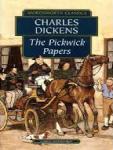The Pickwick Papers

The Posthumous Papers of the Pickwick Club (also known as The Pickwick Papers) is the first novel by Charles Dickens. He was asked to contribute to the project as an up-and-coming writer following the success of Sketches by Boz, published in 1836 (most of Dickens' novels were issued in shilling instalments before being published in the complete volume). Dickens (still writing under the pseudonym of Boz) increasingly took over the unsuccessful monthly publication after the original illustrator Robert Seymour had committed suicide.
Written for publication as a serial, The Pickwick Papers is a sequence of loosely-related adventures. The action is given as occurring 1827–8, though critics have noted some seeming anachronisms. The novel's main character, Samuel Pickwick, Esquire, is a kind and wealthy old gentleman, and the founder and perpetual president of the Pickwick Club. To extend his researches into the quaint and curious phenomena of life, he suggests that he and three other "Pickwickians" (Mr Nathaniel Winkle, Mr Augustus Snodgrass, and Mr Tracy Tupman) should make journeys to remote places from London and report on their findings to the other members of the club. Their travels throughout the English countryside by coach provide the chief theme of the novel. A distinctive and valuable feature of the work is the generally accurate descriptions of the old coaching inns of England.
Its main literary value and appeal is formed by its numerous memorable characters. Each character in The Pickwick Papers, as in many other Dickens novels, is drawn comically, often with exaggerated personalities. Alfred Jingle, who joins the cast in chapter two, provides an aura of comic villainy. His devious tricks repeatedly land the Pickwickians in trouble. These include Jingle's nearly-successful attempted elopement with the spinster Rachael Wardle of Dingley Dell manor, misadventures with Dr Slammer, and others.
Further humour is provided when the comic cockney Sam Weller makes his advent in chapter 10 of the novel. First seen working at the White Hart Inn in The Borough, Weller is taken on by Mr Pickwick as a personal servant and companion on his travels and provides his own oblique ongoing narrative on the proceedings. The relationship between the idealistic and unworldly Pickwick and the astute cockney Weller has been likened to that between Don Quixote and Sancho Panza.
Other notable adventures include Mr Pickwick's attempts to defend a lawsuit brought by his landlady, Mrs Bardell, who (through an apparent misunderstanding on her part) is suing him for the breach of promise to marry her. Another is Mr Pickwick's incarceration at Fleet prison for his stubborn refusal to pay the compensation to her because he doesn't want to give a penny to Mrs Bardell's lawyers, the unscrupulous firm of Messrs. Dodson and Fogg. The general humorous tone is here briefly replaced by biting social satire (including against the legal establishment) and foreshadows major themes in Dickens' later books. Mr Pickwick, Sam Weller, and Weller Senior also appear in Dickens's serial, Master Humphrey's Clock.